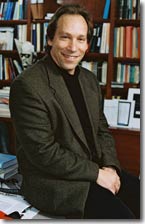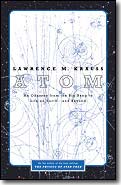Lawrence Krauss
“I got interested in science partly by reading books by scientists,” said Lawrence Krauss, a physicist at Case Western Reserve University in Cleveland, Ohio. “I think that in some sense, [I write books] to return the favor.” Krauss has returned the favor by sharing his knowledge of physics in six books for the public, including the best-selling The Physics of Star Trek.

Lawrence Krauss
Krauss works in a new field called “particle astrophysics” that examines the interactions of two size extremes - fundamental particles smaller than atoms, and the entire universe. “In the past 15 to 20 years,” he said, “the two frontiers of our knowledge, the biggest things in the universe and the smallest things in the universe, have come together. Understanding one requires understanding the other.”
One of Krauss's projects is to search for “dark matter,” mass that scientists can not see directly. By studying how gravity affects galaxies, astronomers know that every galaxy must contain more mass than we can see. We see matter only when it radiates or reflects light; if it does not, the matter will be invisible “dark” matter. According to some gravitational calculations, almost 90% of the matter in the universe is dark.
Scientists have several theories about the nature of dark matter. One theory says that dark matter is a type of subatomic particle that we have not yet observed. If dark matter were a new type of particle, then it should affect the way atoms work. On the other hand, this particle would have mass, so each particle would create gravitational force. Because there is so much dark matter, all these tiny forces taken together would affect the structure of the whole universe. “We might discover [dark matter] in an accelerator first,” Krauss said, “but we might discover it out in the cosmos.” Krauss looks for evidence at both scales. “[I enjoy the] thrill of understanding something that [I] didn't understand before,” he said. “The universe is full of surprises.”
More From Dr. Krauss

Excerpt from ATOM
"Poetry of Imagination"
"Pseudoscience"
"Citizen-Scientists"
Dr. Krauss's books
Born in New York City, Krauss moved with his family to Toronto, Ontario when he was a child. “I liked living in Canada,” he said. “In some ways, I was shocked when I returned to the U.S.” Krauss was always interested in science - in high school, he worked as a volunteer at the Ontario Science Center. His interest in science was also fueled by reading scientists' popular books such as Albert Einstein's Evolution of Modern Physics and Richard Feynman's The Character of Physical Law. Krauss went to college at Carleton University in Ottawa, where he studied history and skated to class along the world's longest public skating canal. He went on to graduate school in physics at the Massachusetts Institute of Technology.
In 1985, Krauss became a professor at Yale University. While still at Yale, Krauss wrote his first book, The Fifth Essence: the Search for Dark Matter in the Universe. In 1993, he left to become chairperson of the physics department at Case Western. In 1995, Krauss wrote The Physics of Star Trek. The book examined the science presented in the TV series Star Trek and Star Trek: the Next Generation. Krauss took ideas from the series, such as faster-than-light warp drive, and analyzed them using ideas of physics as we understand it today. He considers the extent to which warp drive, transporter beams, and holodecks might be possible given the constraints imposed by the laws of physics. “The reason I thought of using [Star Trek] is that it is about possibilities,” Krauss said. “That's what I think physics is about.” The book has sold over 120,000 copies, and Krauss has traveled the country giving public lectures from the book. Krauss enjoys mountain biking and fishing, and is a passionate Cleveland Indians baseball fan. But, he says, his writing has left him with little spare time for these activities. This April, Krauss's sixth book, Atom, will arrive in bookstores. Atom traces the life of a single oxygen atom from the beginning to the end of the universe. Along the way, the atom lands in a comet, in the oceans of Earth, and in deep space. “I think it's my most ambitious book ever,” Krauss said. “After writing it, I didn't view the universe the same way, and I'm hoping the people who read it will feel the same way.”











